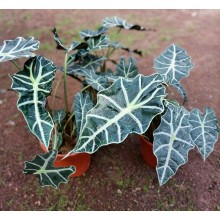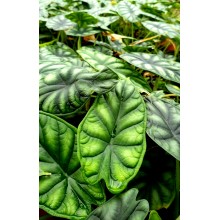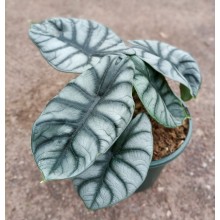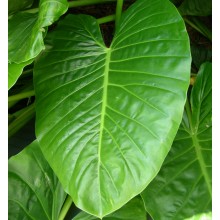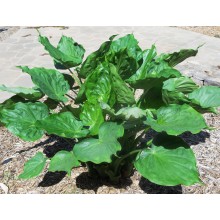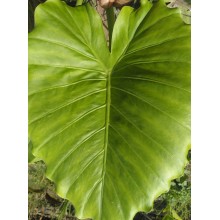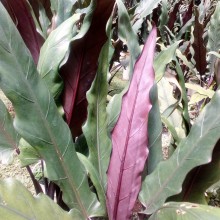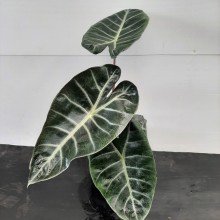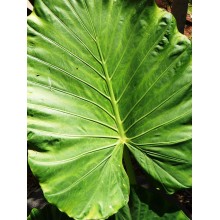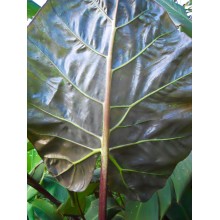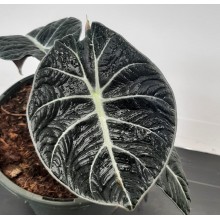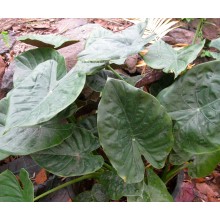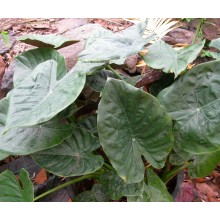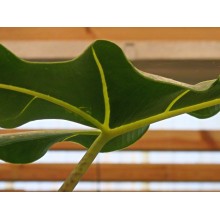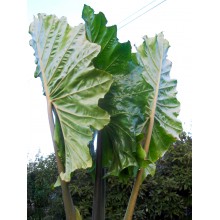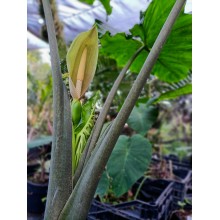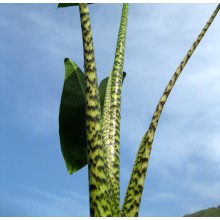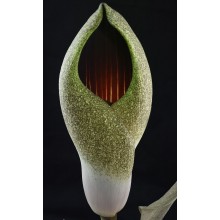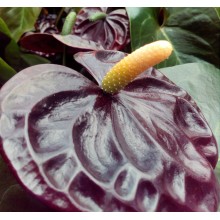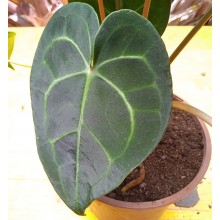Aroids There are 89 products.

The genus Alocasia builds huge leaves, often called elephant-ears and make bold garden centerpieces. Colocasia esculenta is an important food crop, known as taro. It was domesticated in Asia and the Pacific and comes in many cultivars.
Some genera are not evergreen and rest for months (mostly in winter) as underground corms. This is the case of Amorphophallus, a genus also known for its large, unusual and often stinky flowers.
-
Alocasia baginda 'Dragon Scale'
Alocasia baginda 'Dragon Scale'
Small sized Alocasia, with dark green markings.
18,60 € -
Alocasia brisbanensis
Alocasia brisbanensis
This beautiful ornamental is hardier to cold than the other large-leaved Alocasias. It thrives outdoors in the coastal Mediterranean much better than Alocasia macrorrhiza or other species which woud lost most of their foliage in winter.
34,00 € -
Alocasia cucullata
Alocasia cucullata
This is one of the most exotic and adaptable Alocasias, with low, compact growth and hearth-shaped leaves. It is also one of the cold hardiest!
23,00 € -
Alocasia gageana
Alocasia gageana
Looks like a smaller sized relative of Alocasia macrorrhiza, but leaf margins are by far more undulate (wavy). The whole plant will hardly grow above 1-1,5 m in height, while macrorrhiza can easily grow more than 3 m. This smaller species is native to the Kachin Hills in the North of Myanmar.
28,50 € -
Alocasia longiloba 'Pink Dragon'
Alocasia longiloba 'Pink Dragon'
Exceedingly beautiful tropical small Alocasia , with glossy deep green leaves, with prominent silvery veins and pink petioles. Its growth habit is similar to the more widely grown Alocasia x 'Polly'.
16,40 € -
Alocasia macrorrhizos - Elephant Ear Taro
Alocasia macrorrhizos - Elephant Ear Taro
This plant produces huge leaves that can attain 1,5 in a short time. It is a must for tropical-looking gardens but it can take quite a few degrees of frost. It grows well in the coastal mediterranean, with wind protection and abundat water. The stem has some itchy sap but it is edible if cooked for a long time.
23,40 € -
Alocasia plumbea Nigra
Alocasia plumbea Nigra
A classic of all times, this Alocasia has glossy and metallic dark leaves. They show unreal colours of purple to dark green or grey. It does not need hot temperatures to thrive.
26,70 € -
Alocasia reginula 'Black Velvet'
Alocasia reginula 'Black Velvet'
This is tiny gem with unreal foliage. Alocasia reginula is a very small Alocasia, most probably from Borneo, with black, light-reflecting foliage.
16,40 € -
Alocasia wentii
Alocasia wentii
"Hardy Elephant Ear" is a species of Alocasia that can take cold much better than others. It is native to high elevations in New Guinea. Leaf blades reach only 30-40 cm but they are purple-coppery beneath. It is fast growing, it does not require hot conditions and will sprout back after mild frost.
19,40 € -
Alocasia wentii Large
Alocasia wentii Large
"Hardy Elephant Ear" is a species of Alocasia that can take cold much better than others. It is native to high elevations in New Guinea. Leaf blades reach only 30-40 cm but they are purple-coppery beneath. It is fast growing, it does not require hot conditions and will sprout back after mild frost.
44,50 € -
Alocasia x 'Sarian'
Alocasia x 'Sarian'
This extremely beautiful hybrid was developed by crossing Alocasia zebrina and Alocasia micholitziana .
34,00 € -
Alocasia x Portora
Alocasia x Portora
Cold-hardy hybrid of unrivalled beauty. It is a man-made cross of Alocasia odora x Alocasia portei, developed in Florida. It bears magnificent huge leaves, and will survive to frost, to about -10 C. Leaves can reach 1.5 m in length and trunks can grow up to 2 m tall, giving a palm-like appearance.
28,90 € -
Alocasia x Portora- Large 100 cm
Alocasia x Portora- Large 100 cm
Cold-hardy hybrid of unrivalled beauty. It is a man-made cross of Alocasia odora x Alocasia portei, developed in Florida. It bears magnificent huge leaves, and will survive to frost, to about -10 C. Leaves can reach 1.5 m in length and trunks can grow up to 2 m tall, giving a palm-like appearance.We offer a plant with a height of 100 cm and a trunk...
68,90 € -
Alocasia zebrina
Alocasia zebrina
Very beautiful species that can also be used as a potted indoor plant, Alocasia zebrina is endemic to the island of Luzon, in the Philippines archipelago. Leaves are glossy, arrow-shaped, with upright zebra-striped petioles. An astonishing pattern!
36,00 € -
Amorphophallus dracontioides
Amorphophallus dracontioides
A medium sized, rarely available species from Western and Central Africa, with large leaves, to 1,2 m tall, with narrow blades, often >50 cm in diameter.
87,20 € -
Anthurium clarinervium
Anthurium clarinervium
Anthurium clarinervium has thick, cardboard-like leaves that take the shape of a nearly perfect heart. It sports beautiful, sparkling white veins against a deep green, velvety background.
76,90 €
At the moment there are few products in this category Aroids















